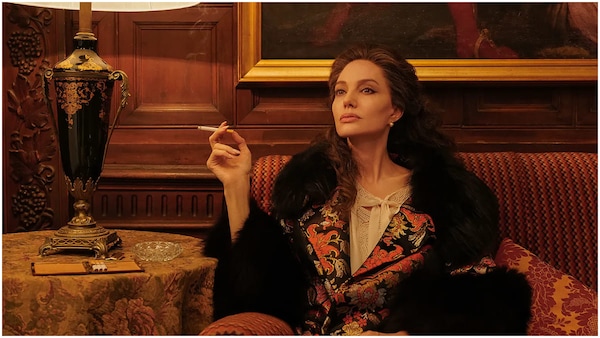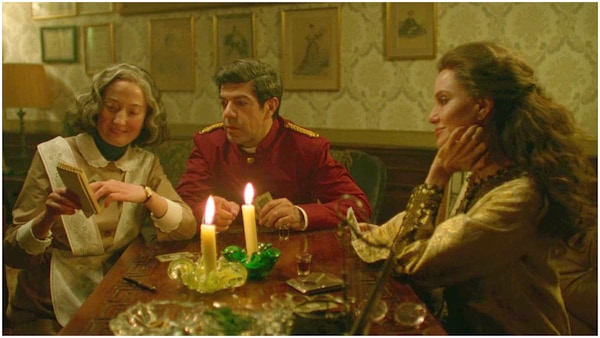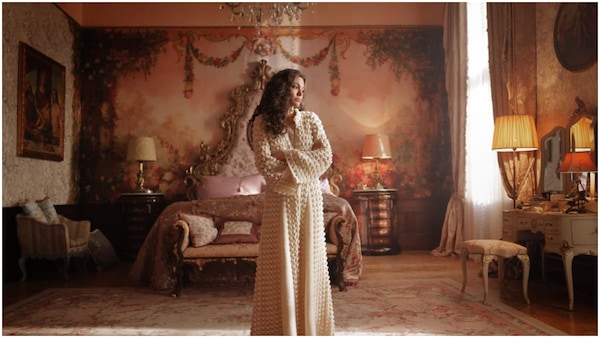Maria Review: Angelina Jolie burns bright in Larraín’s lush ode to a fallen star
Maria Review: Filmmaker Pablo Larraín, alongside Angelina Jolie, embarks on a journey to explore another woman in her most vulnerable moments, peeling back the shiny surface that once defined her.

Last Updated: 10.36 AM, May 08, 2025
Maria Review: Story - Based on the life of the legendary opera singer Maria Callas (Angelina Jolie), set during her twilight years in Paris, which she spent with her loyal butler Ferruccio (Pierfrancesco Favino) and housekeeper Bruna (Alba Rohrwacher); Maria delves into the final seven days of the sensational star who yearns to find her voice, both musically and in the attempt to explain herself to the world. The film follows Maria as she seeks to document her life for a revealing interview, while a journalist persistently questions her, pushing her into uncomfortable revelations that transport her into a series of haunting flashbacks.
Maria Review:
The instinct to scratch beneath the shiny surface and explore what lies underneath is an inherent part of being human. Sometimes, the surface belongs to people who seem untouchable, flawless, and without flaw. Pablo Larraín, a filmmaker deeply invested in his characters and their motivations, is one such person who thrives on peeling back the layers of fame to reveal the humanity underneath. His soul trilogy (unconfirmed)—Jackie (Jacqueline Kennedy), Spencer (Princess Diana), and Maria (Maria Callas)—is an exploration of women with flaws, ambitions, and aspirations buried beneath their glamorous public personas. These are women whose lives demand perfection, leaving them no space to be imperfect or even human. This has been one of the most fascinating character studies of the past decade.
Maria, penned by Steven Knight (creator of Peaky Blinders) and directed by Pablo Larraín, reunites the duo after Spencer to bring this film to life, using the same brushstrokes that painted Kristen Stewart’s portrayal. We meet Maria in the final seven days of her life. The opening scene presents a stark image of people discussing her dead body, but how did she arrive here? Did she ever sing her final song? Was there an audience? Did they validate her? The next two hours take us on a deep dive into these questions and much more, as the music of Maria’s life fills the screen. The first few scenes reveal her commanding presence over the people around her—Ferruccio, Bruna—making us yearn for her to step out and show her panache. And she does. Meanwhile, watch all these fresh releases on Lionsgate, Zee5, and more this week.

However, Pablo Larraín and Steven Knight quickly remind us that she is also a fading star—faded, in fact—because a journalist dares to confront her, bluntly stating that her recent attempt at a stage comeback was a failure, just days before her death. This revelation makes it clear: a woman who once overshadowed Marilyn Monroe is now reduced to booking a table at a restaurant, desperately craving attention. She chooses to sit outside, not in the air-conditioned comfort of the restaurant, but where she can be seen, hoping that praise will be lavished upon her by passersby. Her hunger for applause has become so all-consuming that she no longer hesitates to admit it to the waiter.
The brilliance of Maria lies precisely in this vulnerability. Here is a woman who, as a child, was sold to German soldiers by her own mother, yet went on to become one of the greatest opera stars in the world. This is an unvarnished portrait of a woman who is about to lose her luster entirely and is clinging to her final moments. Unlike Jackie or Spencer, the screenplay strikes a balance between stark black-and-white flashbacks and the vibrant colors of the present day. Its nonlinear structure can, at times, be difficult to follow. For someone unfamiliar with the story, it can be easy to lose track. What works best in this screenplay is the way Pablo and Steven use Maria’s hallucinations as a key plot device—not just as a passing mention, but as an integral element of the film. The narrative unfolds through the eyes of Ferruccio and Bruna, and you, the viewer, become the journalist Maria continually hallucinates.

This approach adds a layer of depth to the story, subtly exploring Maria’s mental struggles without explicitly labeling them. Pierfrancesco Favino brings Ferruccio to life with remarkable authority. He stands before Maria and questions whether the interviewers arriving that day are real or merely products of her mind, reminding her of her mental condition. Yet, when Maria succumbs to an episode, he plays along with her delusions, demonstrating his loyalty and care. Alba Rohrwacher similarly excels in shaping Bruna’s character. Often a silent observer, always present when needed, Alba ensures that Bruna never fades into the background behind Jolie’s commanding presence or the breathtaking architecture, even when she has no spoken lines.
What more can be said about Angelina Jolie’s performance that hasn’t already been said? Returning to the screen after a prolonged hiatus, Jolie proves why she is a star with enduring brilliance. Her portrayal of Maria feels so natural and effortless that you might forget she is the same actor you last saw battling a Celestial in Eternals (Marvel Cinematic Universe). What truly elevates her performance is Pablo’s vision of how the entire film feels like a story unfolding within Maria’s mind. Think of how Princess Diana danced through her narrative in Spencer (a scene I’ll never forget). In Maria, the music flows through her, and she ensures that the climax of her journey is precisely the one she envisioned.
However, Pablo Larraín falters when it comes to presenting the stakes for Maria in a way that resonates powerfully. Unlike his previous subjects—Jacqueline Kennedy, who grappled with the aftermath of JFK’s assassination, and Diana, who challenged the monarchy by resisting a failed marriage—Maria’s stakes feel less urgent. Ultimately, her desire for validation and artistic expression is achieved, but it doesn’t carry the weight that it should. It feels like just another accomplishment in a life soon to be extinguished.

Edward Lachman’s visuals are stunning and completely immerse you from the very first frame. Still, the film might have benefitted from delving deeper into Maria’s time on stage, which could have turned her final performance into a truly celebratory moment.
Maria Review: Final Verdict
An ethereal Angelina Jolie meets Pablo Larraín and Steven Knight in a film that, despite its ambition, offers a middling exploration of a fallen star in her most vulnerable moments.
Maria will be available on Lionsgate Play on May 9, 2025, and can also be streamed with an OTTplay Premium subscription. Stay tuned to OTTplay for more reviews like this and everything else from the world of streaming and films.
Subscribe to our newsletter for top content, delivered fast.

